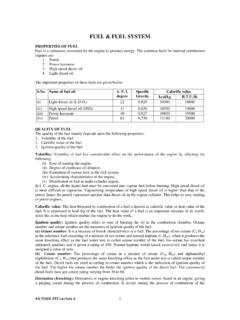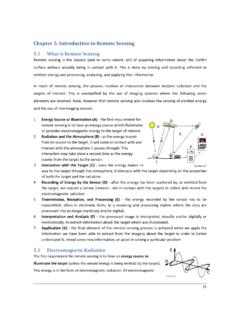Transcription of Lecture 7 Cooling and lubrication - Hill Agric
1 AG ENGG 243 Lecture 7 1 Cooling SYSTEM A system, which controls the engine temperature, is known as a Cooling system. NECESSITY OF Cooling SYSTEM The Cooling system is provided in the IC engine for the following reasons: The temperature of the burning gases in the engine cylinder reaches up to 1500 to 2000 C, which is above the melting point of the material of the cylinder body and head of the engine. (Platinum, a metal which has one of the highest melting points, melts at 1750 C, iron at 1530 C and aluminium at 657 C.) Therefore, if the heat is not dissipated, it would result in the failure of the cylinder material.
2 Due to very high temperatures, the film of the lubricating oil will get oxidized, thus producing carbon deposits on the surface. This will result in piston seizure. Due to overheating, large temperature differences may lead to a distortion of the engine components due to the thermal stresses set up. This makes it necessary for, the temperature variation to be kept to a minimum. Higher temperatures also lower the volumetric efficiency of the engine. REQUIREMENTS OF EFFICIENT Cooling SYSTEM The two main requirements of an efficient Cooling system are: 1. It must be capable of removing only about 30% of the heat generated in the combustion chamber.
3 Too much removal of heat lowers the thermal efficiency of the engine. 2. It should remove heat at a fast rate when the engine is hot. During the starting of the engine, the Cooling should be very slow so that the different working parts reach their operating temperatures in a short time. TYPES OF Cooling SYSTEM There are two types of Cooling systems: (i) Air Cooling system and (ii) Water- Cooling system. AIR Cooling SYSTEM In this type of Cooling system, the heat, which is conducted to the outer parts of the engine, is radiated and conducted away by the stream of air, which is obtained from the atmosphere.
4 In order to have efficient Cooling by means of air, providing fins around the cylinder and cylinder head increases the contact area. The fins are metallic ridges, which are formed during the casting of the cylinder and cylinder head The amount of heat carried off by the air- Cooling depends upon the following factors: (i) The total area of the fin surfaces, (ii) The velocity and amount of the Cooling air and (iii) The temperature of the fins and of the Cooling air. Air- Cooling is mostly tractors of less horsepower, motorcycles, scooters, small cars and small aircraft engines where the forward motion of the machine gives good velocity to cool the engine.
5 Air- Cooling is also provided in some small industrial engines. In this system, individual cylinders are generally employed to provide ample Cooling area by providing fins. A blower is used to provide air. Advantages of Air Cooled Engines Air cooled engines have the following advantages: 1. Its design of air-cooled engine is simple. 2. It is lighter in weight than water-cooled engines due to the absence of water jackets, radiator, circulating pump and the weight of the Cooling water. 3. It is cheaper to manufacture. 4. It needs less care and maintenance. 5. This system of Cooling is particularly advantageous where there are extreme climatic conditions in the arctic or where there is scarcity of water as in deserts.
6 6. No risk of damage from frost, such as cracking of cylinder jackets or radiator water tubes. WATER Cooling SYSTEM It serves two purposes in the working of an engine: AG ENGG 243 Lecture 7 2a) It takes away the excessive heat generated in the engine and saves it from over heating. b) It keeps the engine at working temperature for efficient and economical working. This Cooling system has four types of systems: (i) Direct or non-return system, (ii) Thermo-Syphone system, (iii) Hopper system and (iv) Pump/forced circulation system. Though the present tractor has a forced circulation system, it is still worthwhile to get acquainted with the other three systems.
7 Non-Return Water Cooling System This is suitable for large installations and where plenty of water is available. The water from a storage tank is directly supplied to the engine cylinder. The hot water is not cooled for reuse but simply discharges. The low engine, coupled with the irrigation pump is an example. Thermo-Syphone Water Cooling System This system works on the principle that hot water being lighter rises up and the cold water being heavier goes down. In this system the radiator is placed at a higher level than the engine for the easy flow of water towards the engine. Heat is conducted to the water jackets from where it is taken away due to convection by the circulating water.
8 As the water jacket becomes hot, it rises to the top of the radiator. Cold water from the radiator takes the place of the rising hot water and in this way a circulation of water is set up m the system. This helps in keeping the engine at working temperature. Disadvantages of Thermo-Syphone System 1 Rate of circulation is too slow. 2. Circulation commences only when there is a marked difference in temperature. 3. Circulation stops as the level of water falls below the top of the delivery pipe of the radiator. For these reasons this system has become obsolete and is no more in use. Hopper Water Cooling System This also works on the same principle as the thermo-syphone system.
9 In this there is a hopper on a jacket containing water, which surrounds the engine cylinder. In this system, as soon as water starts boiling, it is replaced by cold water. An engine fitted with this system cannot run for several hours without it being refilled with water. Force Circulation Water Cooling System This system is similar in construction to the thermo-syphone system except that it makes use of a centrifugal pump to circulate the water throughout the water jackets and radiator The water flows from the lower portion of the radiator to the water jacket of the engine through the centrifugal pump.
10 After the circulation water comes back to the radiator, it loses its heat by the process of radiation. This system is employed in cars, trucks, tractors, etc. AG ENGG 243 Lecture 7 3 Parts of Liquid Cooling System The main parts in the water- Cooling system are: (i) water pump, (ii) fan, (iii) radiator and pressure cap, (iv) fan belt (v) water jacket, (vi) thermostat valve, (vii) temperature gauge and (viii) hose pipes. Water Pump This is a centrifugal type pump. It is centrally mounted at the front of the cylinder block and is usually driven by means of a belt. This type of pump consists of the following parts: (i) body or casing, (ii) impeller (rotor), (iii) shaft, (iv) bearings, or bush, (v) water pump seal and (vi) pulley.








